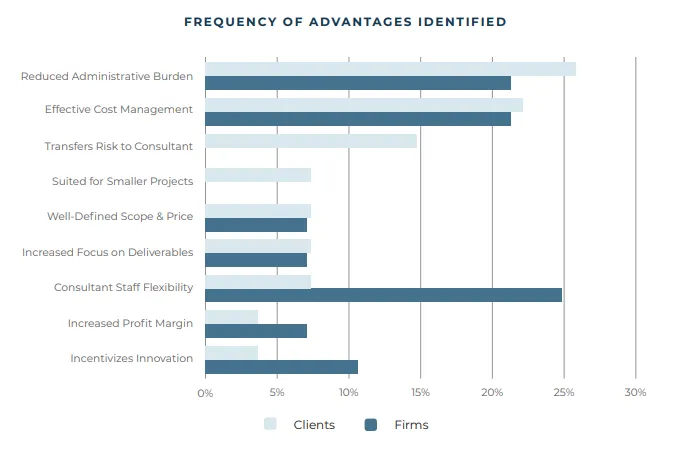Lump sum contracts can benefit owners and engineers alike, according to a new report from the American Council of Engineering Companies. In particular, the delivery method can help unlock the potential of new digital technology like artificial intelligence and enable a sustainable future for engineering and design firms during a time of seismic technological shifts.
Lump sum is a delivery method in which a contractor is paid a specified sum of money for a specific service. Compensation is not adjusted unless substantive changes occur in the scope of services. This delivery method is best suited for projects with a well-defined scope such as road and bridge rehabilitation, researchers found.
The ACEC Research Institute, in partnership with Virginia Tech, commissioned the study to suss out the opportunities and challenges of lump sum structures for engineering and design firms in the transportation sector. Researchers reviewed existing literature and conducted in-depth interviews with representatives of client organizations and engineering firms.
The researchers found that the lump sum delivery method can reduce administrative burden, incentivize effective cost management and encourage technological innovation — an increasingly important consideration amid the emergence of big data, machine learning and generative AI.

Interviewees identified various advantages to using lump sum contracts, according to ACEC.
Courtesy of ACEC
Federal organizations have successfully implemented lump sum contracting for engineering and design services for decades now, but many state DOTs use it sparingly. Instead they rely on cost-plus-fixed-fee contracts with a not-to-exceed price limit, typically based on negotiated levels of effort and duration with established pricing regimes for specified services.
The downside for clients is that these types of contracts do not necessarily incentivize innovation, efficiency and cost-effective service provision, plus they are costly and tedious to administer, according to the researchers. In contrast, lump sum contracts shift the focus to a project’s deliverables rather than its administration.
Challenges of AI, big data
Although new digital technologies have the potential to supercharge the productivity of architects and engineers, that can be a double-edged sword for firms that charge by the hour.
As the data revolution unfolds, engineering firms will need to make massive investments in emerging technologies such as generative AI while also re-training and upskilling their professionals, per ACEC. However, exactly how these technologies will be addressed in the delivery and pricing of engineering and design services remains a question.
“If a consulting engineering firm can deliver the same work product 30% to 50% more efficiently in the future but still charges for its services by the hour, it is fundamentally in a race to the bottom,” according to the study. “This is a business model that is unequivocally unsustainable by any business, let alone one where project and delivery risk is largely transferred to the consulting engineering firm.”
Essentially, engineering and design firms worry this technological shift will cost them twice: They will shoulder the cost of purchasing new tech and training their workers, which will improve efficiency and under the current typical contract structure, cut into their billable hours. ACEC wants a different future, in which engineering firms invest in technology and gain enough benefit to enable a viable long-term business model, while clients receive the full value of their engineering capacity bolstered by cutting-edge tech.
That means engineering and design firms must use a value-based model. Lump sum contracts, which charge for services rendered instead of time and materials, better enable sustainable innovation, according to ACEC.
In order for the AEC industry to benefit from these new technologies, it must reduce friction throughout the project delivery lifecycle, Autodesk’s Vice President of AEC Strategy, Nicolas Mangon, said in the study.
“The industry must encourage the adoption of more incentive-based contracts, like lump sum, so that firms can invest in their ability to leverage digital technology to deliver better project outcomes for their clients,” Mangon said.
Project suitability
Though the researchers found many benefits to lump sum contracts, they are only suitable for projects with well-defined scopes of work. For example, very few interviewees indicated that project development and planning or construction engineering and inspection services were suitable for lump sum, since these phases are difficult to sufficiently define.
Interviewees gave examples of jobs that are suited for lump sum:
- Resurfacing, restoration and rehabilitation projects.
- Interchange and intersection improvements.
- Bridge inspection.
- Culvert replacement.
They also indicated that some projects are less suitable:
- Complex projects with more unknown variables.
- Projects involving significant engagement with third parties.
- Projects that require complex traffic maintenance.
Though there are notable limitations, lump sum contracts enable engineering and design firms to maximize their human and technological resources as they grapple with increased workloads and staffing shortages, the report concluded.
“This increase in autonomy opens up the possibility for better and more creative solutions to engineering/design problems, and this autonomy appears increasingly important as the industry moves into an era where technological changes are mounting, and qualified personnel are scarcer,” according to the study.

